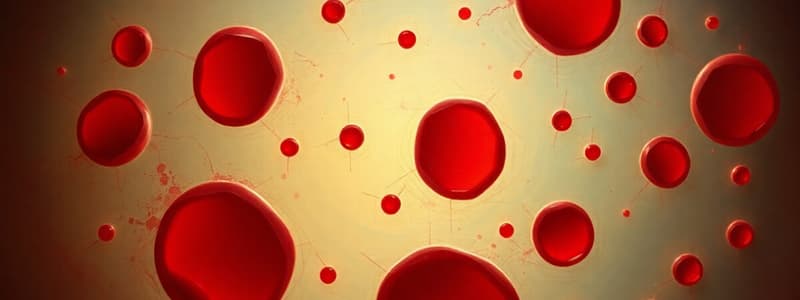Podcast
Questions and Answers
A patient's hematocrit result shows 60%. Which of the following conditions is most likely?
A patient's hematocrit result shows 60%. Which of the following conditions is most likely?
- Leukopenia
- Thrombocytopenia
- Anemia
- Polycythemia (correct)
After centrifuging a blood sample, the buffy coat is significantly thicker than normal. Which of the following conditions might explain this observation?
After centrifuging a blood sample, the buffy coat is significantly thicker than normal. Which of the following conditions might explain this observation?
- Active infection (correct)
- Reduced plasma volume
- Decreased platelet count
- Elevated red blood cell count
Which plasma protein is primarily responsible for maintaining osmotic pressure within blood vessels?
Which plasma protein is primarily responsible for maintaining osmotic pressure within blood vessels?
- Beta globulins
- Alpha globulins
- Albumin (correct)
- Gamma globulins
A patient presents with easy bruising and prolonged bleeding after minor cuts. A complete blood count reveals a platelet count of 100,000 per microliter. Which condition is most likely?
A patient presents with easy bruising and prolonged bleeding after minor cuts. A complete blood count reveals a platelet count of 100,000 per microliter. Which condition is most likely?
Which of the following components found in plasma is most responsible for transporting hormones and insoluble substances?
Which of the following components found in plasma is most responsible for transporting hormones and insoluble substances?
A patient's lab results indicate an elevated level of creatinine in their plasma. This finding most likely suggests an issue with which organ?
A patient's lab results indicate an elevated level of creatinine in their plasma. This finding most likely suggests an issue with which organ?
During an infection, which component of plasma would be expected to increase significantly?
During an infection, which component of plasma would be expected to increase significantly?
A blood sample is centrifuged, and the hematocrit is determined to be 40%. Which of the following could potentially contribute to this result?
A blood sample is centrifuged, and the hematocrit is determined to be 40%. Which of the following could potentially contribute to this result?
Flashcards
Hematocrit
Hematocrit
Percentage of red blood cells in whole blood.
Erythrocytes
Erythrocytes
Red blood cells, making up 45% of blood volume.
Anemia
Anemia
Condition where hematocrit is below 45%.
Polycythemia
Polycythemia
Signup and view all the flashcards
Buffy Coat
Buffy Coat
Signup and view all the flashcards
Plasma
Plasma
Signup and view all the flashcards
Leukopenia
Leukopenia
Signup and view all the flashcards
Thrombocytopenia
Thrombocytopenia
Signup and view all the flashcards
Study Notes
Hematocrit
- Hematocrit, also called packed cell volume (PCV), is the percentage of red blood cells in a whole blood sample.
- A standard hematocrit is obtained by drawing blood from a vein (e.g., median cubital vein) and centrifuging it.
- Centrifuging blood separates it into three layers based on density:
- Erythrocytes (Red Blood Cells): The densest layer, typically 45% of total blood volume.
- Anything below 45% is considered anemia.
- Anything above 45% is considered polycythemia.
- Buffy Coat: A thin, middle layer containing white blood cells (leukocytes) and platelets.
- Accounts for less than 1% of total blood volume.
- Plasma: The less dense, uppermost liquid layer.
- Accounts for approximately 55% of total blood volume.
- Erythrocytes (Red Blood Cells): The densest layer, typically 45% of total blood volume.
- Buffy Coat
- Platelets: Responsible for blood clotting, with a normal count of 150,000 to 450,000 per microliter.
- Less than 150,000 platelets is called thrombocytopenia, which increases the risk of bleeding.
- Greater than 450,000 platelets is called thrombocytosis, which increases the risk of clotting.
- White Blood Cells (Leukocytes): Normal count is 4,800 to 11,000 per microliter.
- Less than 4,800 leukocytes is called leukopenia, a sign of immune suppression.
- Greater than 11,000 leukocytes is called leukocytosis, often indicating an infection.
- Platelets: Responsible for blood clotting, with a normal count of 150,000 to 450,000 per microliter.
- Plasma
- Primarily composed of water (90-93%) acting as a universal solvent for transporting blood cells, solutes, nutrients, and waste products.
- Contains plasma proteins (8%) which regulate blood volume and pressure.
- Albumin (60%): Regulates water balance and osmotic pressure within blood vessels.
- Globulins (30%): alpha and beta globulins function as transport proteins for insoluble substances like iron and hormones, while gamma globulins are antibodies produced by plasma cells (differentiated B cells) for fighting pathogens.
- Also contains:
- Respiratory Gases: Oxygen, carbon dioxide, and nitric oxide.
- Electrolytes: Sodium, potassium, chloride, etc.
- Nutrients: Glucose, amino acids, fatty acids.
- Enzymes: Anti-microbial and functional enzymes.
- Hormones: Hormones in the bloodstream are transported via plasma.
- Metabolic Waste: Lactic acid, uric acid, creatinine, etc. Plasma transports these waste products to organs like the kidneys and liver for excretion.
- Normal red blood cell count is around 5 to 6 million per microliter.
Studying That Suits You
Use AI to generate personalized quizzes and flashcards to suit your learning preferences.




